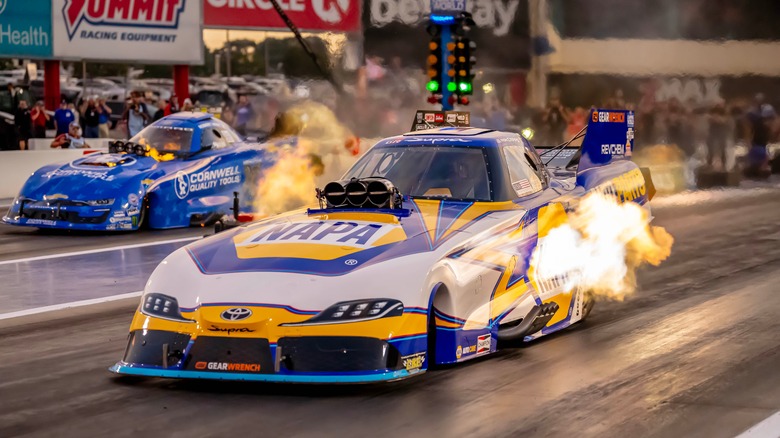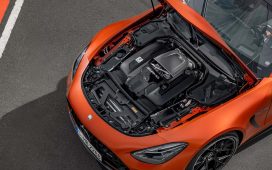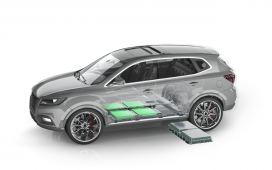There’s really nothing amusing about replacing or rebuilding an engine, but when you’re in the National Hot Rod Association’s funny-looking Super Stock drag-racing business, it’s all part of the gig. In fact, an engine in today’s Funny Cars must be wholly rebuilt (or replaced) after — are you ready for this? — just four seconds of open-throttle use.
Advertisement
The origin of the name “funny car” isn’t precisely known, but pretty much everyone agrees it came to fruition somewhere during the middle of the 1960s. There are even a few competing origin stories about how the name came to be. One states it was coined by an announcer who thought the drag-racing stock cars looked “funny.” Another (backed by racing historian Leo Levine) gives credit to the head of Mercury’s racing program at the time, Fran Hernandez, who said, “We need to beat those ‘funny’ cars,” again referring to their funny-looking appearance.
They weren’t initially called “funny cars” at all. Some of the first ones were Hemi Dodges from the ’60s, while others were stock late-model two-door muscle cars or even factory experimental cars (including Pontiac’s excellent “Swiss Cheese” Catalina). They were stripped down, had their wheelbases made shorter, and equipped with lightweight parts and massive engines.
Advertisement
While the first ones started racing around 1964, they weren’t officially integrated into the NHRA until 1969. Their “funny” style would later evolve into the long, wedge-shaped flame-throwing beasts with the flip-open body we know today.
You don’t mess around with nitromethane
Much like the bodies, their engines also changed. The first used were straight 426 Hemi V8s running on gas (one of the iconic engines that changed racing forever), but that quickly changed over to supercharged engines that ran on nitromethane (aka rocket fuel), a liquid that actually developed to clean printing presses.
Advertisement
The eight-cylinder supercharged engines that sit in today’s funny cars (and top fuel dragsters) pump out over 10,000 horsepower and burn through 14 gallons of nitromethane in less than four seconds as they scream down the quarter-mile drag strip. By the time the 2,600-pound speed demon crosses the finish line, it’s going approximately 330 mph.
Nitromethane has a specific energy value six times greater than regular gas, and a drag engine can burn through over eight times more nitromethane than gasoline per each power stroke. Ultimately, this printing press cleaner/rocket fuel generates more than double the power of gas (if combined with the same amount of oxygen).
It’s an incredibly tricky substance to work with. You can literally light a match while standing next to an open bucket of the stuff without danger, but if you place just a few drops on something and strike it with a hammer, it’ll cause a small explosion.
Advertisement
Replacing an engine takes less than an hour
When the funny car explodes (almost literally) off the starting line, the power is so ferocious, it buckles the tires and shakes the ground. Flames belch from the exhaust, and sonic waves emanate from the vehicle. The engine can explode if the tires somehow lose even the slightest bit of traction.
Advertisement
“These engines are right there flirting with the limits,” says Davin Reckow, who writes for Hagerty and owns Sling Shot Dragsters and The Chassis Farm. “Every team is trying to dump the maximum fuel it can into its motor. …
“There’s a very fine line between burning [fuel] and hydrolocking,” which occurs when there’s too much fuel in the cylinders, causing pistons and other engine parts to lock up immediately. That’s a worst-case scenario when you’re going 300-plus mph.
With so much horsepower and firepower pouring through and erupting from these engines, it’s no wonder they don’t last long. While one can last about a dozen runs before it must be replaced entirely, they’re almost always torn down and reassembled after each run using a combination of refurbished and new parts.
Advertisement
Elimination rounds typically only have 35 minutes of downtime between them, so pit crews for funny cars can complete a teardown and rebuild in less time than it takes to watch an episode of your favorite show. And during any given race weekend, the engine can go through this process several times.








